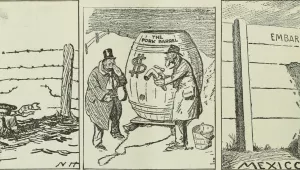US consumer sentiment, by one measure, is at its lowest level since 2011. More Americans say they hear mostly negative news about the economy than hear positive news, or a balance of positive and negative. Most remarkably, 57% tell pollsters they believe we are currently in recession versus only 21% who do not.
So, is the US economy already in a recession? No. People are unhappy with inflation, which has recently been running 8.3 % [CPI change, from April 2021 to April 2022]. That is the highest since 1982. But inflation is not recession. Recession is defined as a significant decline in economic activity. Economic activity is not falling. Quite the contrary: it has been booming. It is worth spelling out the evidence.
- Is GDP falling?
In many countries, a recession is defined as two consecutive quarters of negative GDP growth. In the United States, the official arbiter of recessions is the Business Cycle Dating Committee of the National Bureau of Economic Research (NBER), a private non-profit research organization. The NBER committee does not use any mechanical rule.
What does the NBER committee look at to decide if there has been a significant decline in economic activity? The most important criterion is whether there has been a decrease in national output [Gross Domestic Output]. GDP has risen rapidly since the start of 2021, at 4 % per annum, averaging over the five quarters.
In addition to GDP, the NBER also looks at a second measure of national output, called GDI.[1] The most recent data indicate that output rose slightly in the first quarter of 2022 at about 0.3% per annum. [This is the average of GDP growth, at -1.5 % per annum, and GDI growth, at +2.1% — both reported on May 26, by the US BEA.]
There is no reason to think that growth is now turning negative. Indeed, domestic demand has continued strong, including in the first quarter, making it likely that the expansion is now continuing in the second quarter.
- Other indicators of recession
The second most important criterion of recession is the state of the labor market. Here, employment is traditionally the primary indicator. But other relevant measures of whether the labor market is tight or loose include: the unemployment rate, the ratio of employment to population, and job vacancies. By virtually all such measures, the labor market is booming. The unemployment rate is 3.6%, close to the lowest it has been in 50 years. There are currently almost 2.0 job vacancies for every unemployed worker, the highest that ratio has been since the data were first collected.
The start of a recession is marked by a peak in the business cycle. To pinpoint the precise month of a turning point, the NBER Committee also looks at other indicators, including real personal income less transfers, real personal consumption expenditures, real sales and industrial production. Like national output and employment, these measures do not currently suggest a downturn.
At some point there will be another recession. But the odds that it will hit the US this year are nowhere near as high as people seem to think. In a random year, the odds are about 15%. Currently they are higher than that. But not much.
To be sure, there are serious risks internationally. The EU economy will be negatively impacted by cuts in imports of Russian oil and gas. China’s economy will be negatively impacted by shutdowns in pursuit of zero Covid. Emerging Market economies will be negatively impacted by rising global interest rates and a stronger dollar. These could all have spillover effects.
- But what about inflation?
Does the high level of US inflation make a recession likely? There is a sense in which inflation and recession are opposite conditions. The factors that drove the strong economic recovery, following the Covid-19 recession of early 2020, also drove inflation up. They included expansionary monetary policy by the Fed and expansionary fiscal policy by the White House and Congress, mostly transfers that boosted households’ disposable income (some of which they saved and are spending this year, after the programs have run out). These factors boosted demand in 2020 and 2021.
In light of the ensuing inflation, macroeconomic stimulus was probably excessive. Still, it is good that we were able to bring unemployment down below 4% in less than two years, from 14.7 % in April 2020. We are much better off than we were after the Great Recession of 2007-09, when fiscal stimulus was too little and too short-lived, with the result that it took nine years to bring unemployment down below 4 %.
One often reads that inflation induces consumers to cut spending. But the effect is more likely to be the reverse. Inflation is defined, not as a one-time increase in prices, but as an ongoing upward trend in the price level. When inflation is high, households and firms often spend more, reacting to the likelihood that goods prices will be even higher tomorrow than they are today.
It is certainly true that not all of the current inflation can be attributed to expanding demand. Supply chain disruptions and increases in global prices for oil and other commodities have pushed inflation up as well.
There is indeed a sense in which high inflation can lead to recession. Sooner or later, the central bank has to raise interest rates in order to restrain demand and bring inflation down to a sustainable level, like 2 %. It is tricky to pull this off without a recession. That is the main reason why a downturn at some point in the next two years is more likely than usual. The Fed has raised the short-term interest rate by 0.75 percentage points since February, and has indicated that it will continue the tightening trend.
But the interest rate has a long way to go. For 2022, monetary policy still counts as easy. For now, economic activity will probably continue to expand.
Frankel, Jeffrey. “No, the US is Not in Recession.” June 9, 2022




